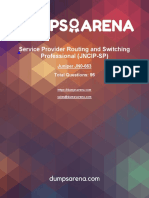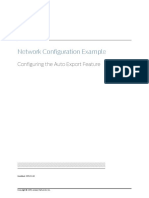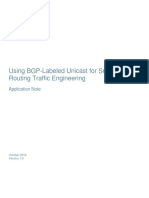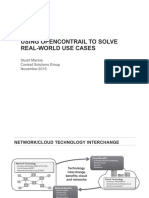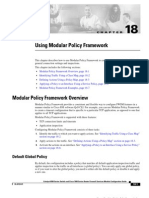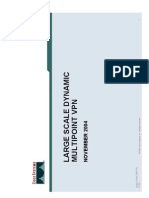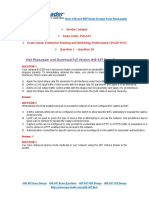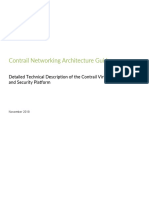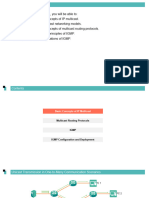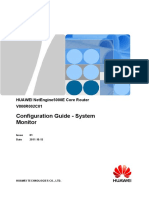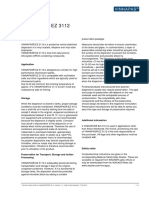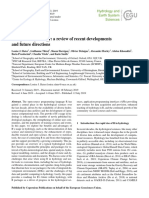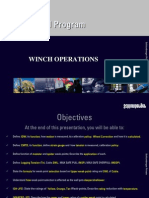0 ratings0% found this document useful (0 votes)
106 viewsDHCP
DHCP
Uploaded by
TuPro FessionalThe document discusses DHCP (Dynamic Host Configuration Protocol) and how it is used to automatically assign IP addresses to devices on a network. It describes the basic DHCP client/server communication process including discover, offer, request, and acknowledgement messages. It then provides examples of configuring a Juniper SRX device to act as both a DHCP client and server, and also as a DHCP relay agent to pass requests to an external server. Configuration and verification commands are provided.
Copyright:
© All Rights Reserved
Available Formats
Download as DOCX, PDF, TXT or read online from Scribd
DHCP
DHCP
Uploaded by
TuPro Fessional0 ratings0% found this document useful (0 votes)
106 views5 pagesThe document discusses DHCP (Dynamic Host Configuration Protocol) and how it is used to automatically assign IP addresses to devices on a network. It describes the basic DHCP client/server communication process including discover, offer, request, and acknowledgement messages. It then provides examples of configuring a Juniper SRX device to act as both a DHCP client and server, and also as a DHCP relay agent to pass requests to an external server. Configuration and verification commands are provided.
Original Description:
DHCP.docx
Original Title
DHCP.docx
Copyright
© © All Rights Reserved
Available Formats
DOCX, PDF, TXT or read online from Scribd
Share this document
Did you find this document useful?
Is this content inappropriate?
The document discusses DHCP (Dynamic Host Configuration Protocol) and how it is used to automatically assign IP addresses to devices on a network. It describes the basic DHCP client/server communication process including discover, offer, request, and acknowledgement messages. It then provides examples of configuring a Juniper SRX device to act as both a DHCP client and server, and also as a DHCP relay agent to pass requests to an external server. Configuration and verification commands are provided.
Copyright:
© All Rights Reserved
Available Formats
Download as DOCX, PDF, TXT or read online from Scribd
Download as docx, pdf, or txt
0 ratings0% found this document useful (0 votes)
106 views5 pagesDHCP
DHCP
Uploaded by
TuPro FessionalThe document discusses DHCP (Dynamic Host Configuration Protocol) and how it is used to automatically assign IP addresses to devices on a network. It describes the basic DHCP client/server communication process including discover, offer, request, and acknowledgement messages. It then provides examples of configuring a Juniper SRX device to act as both a DHCP client and server, and also as a DHCP relay agent to pass requests to an external server. Configuration and verification commands are provided.
Copyright:
© All Rights Reserved
Available Formats
Download as DOCX, PDF, TXT or read online from Scribd
Download as docx, pdf, or txt
You are on page 1of 5
System Services - DHCP
DHCP (Dynamic Host Configuration Protocol) is a client / server protocol used
to automatically assign an IP address to a node on the network. The following basic
breakdown outlines the messages that take place when a host acquires an IP address
using DHCP.
Discover - In this message the client broadcasts a request using UDP port 67. Some
options or attributes can be included in the address such as requesting to have the same
address the client might have had before.
Offer - In this message a DHCP server responds to the client on UDP port 68. This
message includes the IP address and lease information the server is offering the client.
Request - In this message the client responds to the server to confirm the offer. The
client may receive many offers from multiple DHCP servers. It will only choose and respond
to one offer.
Acknowledgement - In this message the server confirms to the client that the IP
address has been allocated to the client.
The Juniper SRX can be configured as a DHCP server, DHCP client or both.
DHCP Client Configuration & Validation
In this exercise the public interface of the SRX100 will be configured as a DHCP client. This
will allow the SRX to acquire a public IP address from the ISP. The following diagram
outlines the basic topology.
The following command configures interface fe-0/0/0 on the SRX100 acquire an IP address
via DHCP. The first command enables DHCP on the interface fe-0/0/0 and the second
command sets DHCP as an inbound service.
set interfaces fe-0/0/0 unit 0 family inet dhcp
set security zones security-zone INTERNET interfaces fe-0/0/0.0 host-inbound-traffic
system-services dhcp
The following command can be used to verify DHCP client operation.
DHCP Server Configuration & Validation
In this exercise the SRX100 will be configured as a DHCP server for the internal network of
192.168.1.0/24. The following diagram outlines the basic topology.
The following commands configure the SRX100 to function as a DHCP server. The first
command sets the range of addresses that can be handed out to clients. The three
commands set parameters that can be passed to the client, in this case they are DNS and a
default gateway. Other parameters such as WINS, domain name or vendor specific options
can also be specified. The last command allows DHCP as an inbound service on the LAN
interface of the SRX.
set system services dhcp pool 192.168.1.0/24 address-range low 192.168.1.100 high
192.168.1.150
set system services dhcp pool 192.168.1.0/24 name-server 8.8.8.8
set system services dhcp pool 192.168.1.0/24 name-server 8.8.4.4
set system services dhcp pool 192.168.1.0/24 router 192.168.1.1
set security zones security-zone TRUST interfaces vlan.192 host-inbound-traffic system-
services dhcp
The following commands can be used to verify DHCP server operation.
show system services dhcp pool - This command outlines the DHCP pools configured with
the ranges included.
show system services dhcp binding - This command outlines the current addresses that are
assigned to clients including the lease times.
show system services dhcp statistics - This command outlines some counters and stats for
DHCP.
show system services dhcp conflicts - This command outlines conflicts such as duplicate IP
use.
The screenshot below outlines these commands.
DHCP Relay Configuration & Validation
DHCP is broadcast based, if the client and server are on different networks the DHCP
server will not see the requests from the client. In this exercise the SRX100 will be
configured to relay DHCP requests to an external DHCP server. The following diagram
outlines the basic topology.
The following commands configure the SRX100 to function as a DHCP relay agent.
set forwarding-options helpers bootp description "DHCP Relay"
set forwarding-options helpers bootp server 192.168.2.100
set forwarding-options helpers bootp interface vlan.192
set security zones security-zone TRUST interfaces vlan.192 host-inbound-traffic system-
services dhcp
set security zones security-zone TRUST interfaces vlan.193 host-inbound-traffic system-
services dhcp
The following commands can be used to verify DHCP relay operation.
You might also like
- ADCX V18A SG - Vol.1Document372 pagesADCX V18A SG - Vol.1TuPro Fessional100% (1)
- DC Surge Protection Solutions For Rooftop or Towertop: Data SheetDocument2 pagesDC Surge Protection Solutions For Rooftop or Towertop: Data SheetNick Butcher67% (3)
- AJSPR V19A SG - Vol.2Document419 pagesAJSPR V19A SG - Vol.2TuPro FessionalNo ratings yet
- Elephant Sleeping On Moon: DIY Papercraft Template PDFDocument21 pagesElephant Sleeping On Moon: DIY Papercraft Template PDFmariafacostan100% (3)
- AJSPR V19A LG - Vol.2Document310 pagesAJSPR V19A LG - Vol.2TuPro FessionalNo ratings yet
- User Manual - JPD-FR100+Document6 pagesUser Manual - JPD-FR100+Kassius Marcelo50% (2)
- Adcx V18a LGDocument300 pagesAdcx V18a LGTuPro FessionalNo ratings yet
- ADCX V18A SG - Vol.2Document403 pagesADCX V18A SG - Vol.2TuPro Fessional0% (1)
- JN0 663 Premium Unlocked YDocument87 pagesJN0 663 Premium Unlocked YTuPro FessionalNo ratings yet
- RECKLABS-Managed ServicesDocument22 pagesRECKLABS-Managed ServicesTuPro FessionalNo ratings yet
- Plumbing Q and A With Answer PDFDocument8 pagesPlumbing Q and A With Answer PDFrrpenolio0% (1)
- TIP005 - MP3000 - MP3000a Alarm CodesDocument2 pagesTIP005 - MP3000 - MP3000a Alarm CodesSerhii75% (4)
- Emco Concept TURN 55 Brochure ENDocument4 pagesEmco Concept TURN 55 Brochure ENP72097100% (1)
- WAN TECHNOLOGY FRAME-RELAY: An Expert's Handbook of Navigating Frame Relay NetworksFrom EverandWAN TECHNOLOGY FRAME-RELAY: An Expert's Handbook of Navigating Frame Relay NetworksNo ratings yet
- MCSA Windows Server 2012 R2 Complete Study Guide: Exams 70-410, 70-411, 70-412, and 70-417From EverandMCSA Windows Server 2012 R2 Complete Study Guide: Exams 70-410, 70-411, 70-412, and 70-417No ratings yet
- Visit Passleader and Download Full Version Jn0-333 Exam DumpsDocument5 pagesVisit Passleader and Download Full Version Jn0-333 Exam DumpsbrotherNo ratings yet
- Chained Composite Next HopDocument3 pagesChained Composite Next HopSivaraman AlagappanNo ratings yet
- Configuring Ospf: Robert Pradeepan SrilankaDocument142 pagesConfiguring Ospf: Robert Pradeepan Srilankanvbinh2005No ratings yet
- Introduction To Border Gateway Protocol (BGP 4)Document93 pagesIntroduction To Border Gateway Protocol (BGP 4)Meklati YounessNo ratings yet
- CSPFDocument38 pagesCSPFNhan BienNo ratings yet
- Guide For Junos UpgradeDocument19 pagesGuide For Junos UpgradeFuad FissilNo ratings yet
- Understanding FabricPath - Data Center and Network TechnobabbleDocument4 pagesUnderstanding FabricPath - Data Center and Network TechnobabbletorNo ratings yet
- TW QFabric TrafficFlowsDocument82 pagesTW QFabric TrafficFlowsAlaa Al-saggafNo ratings yet
- Auto Export UnderstandingDocument12 pagesAuto Export UnderstandingBon Tran HongNo ratings yet
- Ip Multicast Troubleshooting GuideDocument28 pagesIp Multicast Troubleshooting GuideWilbur SloesarwijNo ratings yet
- Dynamips Tutorial 11032010Document23 pagesDynamips Tutorial 11032010HUT_8X_PROONo ratings yet
- IchipDocument137 pagesIchipSivaraman AlagappanNo ratings yet
- Nog Mpls FRR PDFDocument232 pagesNog Mpls FRR PDFMoïse GuilavoguiNo ratings yet
- Mesaje System JuniperDocument54 pagesMesaje System JuniperŞerban BârlăuNo ratings yet
- B Cisco Nexus 9000 Series NX-OS System Management Configuration Guide 7x Chapter 011100Document16 pagesB Cisco Nexus 9000 Series NX-OS System Management Configuration Guide 7x Chapter 011100Mario MatizNo ratings yet
- PT15510 PDFDocument4 pagesPT15510 PDFCuong HaNo ratings yet
- Mapjncis SPDocument1 pageMapjncis SPAmine BoubakeurNo ratings yet
- Avaya TemplateDocument4 pagesAvaya TemplateMohamad MhannaNo ratings yet
- SRX For BeginnersDocument6 pagesSRX For BeginnersSon Tran Hong NamNo ratings yet
- Jljntper: Ativanced Junos Enterprise Security TroubleshootingDocument23 pagesJljntper: Ativanced Junos Enterprise Security TroubleshootingAssem SamirNo ratings yet
- BGP Lu Segment Routing Te PDFDocument8 pagesBGP Lu Segment Routing Te PDFSomantriNo ratings yet
- Ccna4-Lab 1: Nat & Pat: Scenario For NAT ConfigurationDocument2 pagesCcna4-Lab 1: Nat & Pat: Scenario For NAT ConfigurationNhựt LưuNo ratings yet
- Contrail Use CasesDocument35 pagesContrail Use Casessripathy.balaji4908100% (1)
- Modular Policy Framework - MPFDocument10 pagesModular Policy Framework - MPFKroma TuxtlaNo ratings yet
- CCIE Day Practice Lab 2Document4 pagesCCIE Day Practice Lab 2Manuel Huertas HonoresNo ratings yet
- Configuring BGP On Cisco Routers: Student GuideDocument356 pagesConfiguring BGP On Cisco Routers: Student GuideReinaldo OrNo ratings yet
- Large Scale DMVPNDocument35 pagesLarge Scale DMVPNsaimunNo ratings yet
- Website: Vce To PDF Converter: Facebook: Twitter:: Jpr-961.Vceplus - Premium.Exam.65QDocument26 pagesWebsite: Vce To PDF Converter: Facebook: Twitter:: Jpr-961.Vceplus - Premium.Exam.65QAry FajriNo ratings yet
- JSEC EX InstructorNotes 30may2010Document9 pagesJSEC EX InstructorNotes 30may2010Jorge GaitanNo ratings yet
- Configuring and Deploying SRX3xx, SRX550M, and SRX1500 Services GatewaysDocument28 pagesConfiguring and Deploying SRX3xx, SRX550M, and SRX1500 Services GatewaysSpartiate BusinessNo ratings yet
- Basic & Advanced Syllabus of MikrotikDocument3 pagesBasic & Advanced Syllabus of Mikrotikabhi281100% (1)
- Remote ExploitationDocument2 pagesRemote Exploitationapi-22231386No ratings yet
- Auto Export Understanding PDFDocument12 pagesAuto Export Understanding PDFbroakin1311No ratings yet
- PassLeader JN0-647 Exam Dumps (1-20)Document11 pagesPassLeader JN0-647 Exam Dumps (1-20)Vlad AndreiasNo ratings yet
- Interfaces Ethernet SwitchesDocument1,600 pagesInterfaces Ethernet SwitchesIftikhar JavedNo ratings yet
- FSSODocument72 pagesFSSOkokeyoh801No ratings yet
- Brief Previliage Cisco CommandDocument3 pagesBrief Previliage Cisco CommandSenan AlkaabyNo ratings yet
- Ha en Switches CiscoDocument95 pagesHa en Switches CiscoRoger VillarrealNo ratings yet
- SG 010 Contrail Networking Arch GuideDocument53 pagesSG 010 Contrail Networking Arch GuidedhkhtnNo ratings yet
- GNS3 - Packet CaptureDocument3 pagesGNS3 - Packet Captureclu5t3rNo ratings yet
- 23 Multicast+Basics+-+IGMP+PrinciplesDocument53 pages23 Multicast+Basics+-+IGMP+PrinciplesMuhammad TanveerNo ratings yet
- Jsec 17.aDocument2 pagesJsec 17.aRizwan Ahmed AnsariNo ratings yet
- CCNA Routing & Switching 200-120 Exam Q&ADocument16 pagesCCNA Routing & Switching 200-120 Exam Q&AZack Carter100% (2)
- Intro Juniper 1Document45 pagesIntro Juniper 1Phylipi Reis TorresNo ratings yet
- 01 - Basic Management ConfigurationDocument54 pages01 - Basic Management ConfigurationHuỳnh Ngọc ThươngNo ratings yet
- NQA - Configuration Guide - System Monitor (V800R002C01 - 01)Document83 pagesNQA - Configuration Guide - System Monitor (V800R002C01 - 01)Orlando RangelNo ratings yet
- Lecture 4 - Static+Dynamic RoutingDocument51 pagesLecture 4 - Static+Dynamic RoutingAbdul OmarNo ratings yet
- CCN Lab Manual FullDocument39 pagesCCN Lab Manual FullfaizaNo ratings yet
- Multicast SolutionsDocument10 pagesMulticast SolutionsxploreNo ratings yet
- Lecture 10 IP Traffic Management-QoS ConceptsDocument45 pagesLecture 10 IP Traffic Management-QoS ConceptsprakashNo ratings yet
- BGP Peer /NBR Communication MessageDocument5 pagesBGP Peer /NBR Communication MessageskydonNo ratings yet
- 04-Chapter4 OSPF ConfigurationDocument70 pages04-Chapter4 OSPF ConfigurationRandy DookheranNo ratings yet
- Basic Trouble Shooting With VPLS: JTAC - Steven WongDocument97 pagesBasic Trouble Shooting With VPLS: JTAC - Steven WongSivaraman AlagappanNo ratings yet
- Ex4600 Ethernet Switch: Product OverviewDocument13 pagesEx4600 Ethernet Switch: Product OverviewTrần Hoàng ThôngNo ratings yet
- Netra 240 Server Service ManualDocument150 pagesNetra 240 Server Service Manualmkmack100% (1)
- STB - Thong Bao Ngay DKCC VV Hop DHDCDTN Nam TC 2021Document2 pagesSTB - Thong Bao Ngay DKCC VV Hop DHDCDTN Nam TC 2021TuPro FessionalNo ratings yet
- New IP Technologies PDFDocument3,180 pagesNew IP Technologies PDFmhmdmhmdNo ratings yet
- Đề cương ôn tậpDocument27 pagesĐề cương ôn tậpTuPro FessionalNo ratings yet
- MPLSSDNNFV Eantc Guided Tours 3Document34 pagesMPLSSDNNFV Eantc Guided Tours 3TuPro FessionalNo ratings yet
- Network Infrastructure Network Deployment With Segment RoutingDocument25 pagesNetwork Infrastructure Network Deployment With Segment RoutingTuPro FessionalNo ratings yet
- EANTC NETCONFYANG SDN MGMT Interop Test 2021 WhitePaperDocument21 pagesEANTC NETCONFYANG SDN MGMT Interop Test 2021 WhitePaperTuPro FessionalNo ratings yet
- Northstar Controller User GuideDocument601 pagesNorthstar Controller User GuideTuPro FessionalNo ratings yet
- Juniper Networks: Investor RelationsDocument33 pagesJuniper Networks: Investor RelationsTuPro FessionalNo ratings yet
- PR1484233 - Juniper Networks PR SearchDocument1 pagePR1484233 - Juniper Networks PR SearchTuPro FessionalNo ratings yet
- Network Slicing and Enhanced VPNS: Adrian Farrel: Old Dog ConsultingDocument35 pagesNetwork Slicing and Enhanced VPNS: Adrian Farrel: Old Dog ConsultingTuPro FessionalNo ratings yet
- SPRING - Advanced Use Cases: Aditya Kaul - Solution ArchitectDocument31 pagesSPRING - Advanced Use Cases: Aditya Kaul - Solution ArchitectTuPro FessionalNo ratings yet
- SSMMX01F ML5Document69 pagesSSMMX01F ML5TuPro FessionalNo ratings yet
- 5.mxasdcedge Public VersionDocument34 pages5.mxasdcedge Public VersionTuPro FessionalNo ratings yet
- Website: Vce To PDF Converter: Facebook: Twitter:: Jn0-681.Vceplus - Premium.Exam.65QDocument35 pagesWebsite: Vce To PDF Converter: Facebook: Twitter:: Jn0-681.Vceplus - Premium.Exam.65QTuPro FessionalNo ratings yet
- Detail Lab GuideDocument256 pagesDetail Lab GuideTuPro FessionalNo ratings yet
- CERT-Appearance-Gingoog CityDocument1 pageCERT-Appearance-Gingoog CityEnforcement DivisionNo ratings yet
- LUNOS Catalogue For Home VentilationDocument68 pagesLUNOS Catalogue For Home Ventilationing urbanNo ratings yet
- Amit - Automation Using SeleniumDocument30 pagesAmit - Automation Using SeleniumReynaldi DwiNo ratings yet
- Research-Based Keyboarding Instruction For The 21st Century - ZeitzDocument26 pagesResearch-Based Keyboarding Instruction For The 21st Century - ZeitzLeigh ZeitzNo ratings yet
- Exam1c SolDocument13 pagesExam1c SolDmdhineshNo ratings yet
- Siemens Mosaic Vibhavadi DrawingDocument61 pagesSiemens Mosaic Vibhavadi Drawingสหชัย น้อยคํามีNo ratings yet
- xtp698 Zcu670 System Controller Es 2021 1Document54 pagesxtp698 Zcu670 System Controller Es 2021 1poojitha srikanthNo ratings yet
- TC72 - Digital Temperature Sensor With SPI ™ InterfaceDocument24 pagesTC72 - Digital Temperature Sensor With SPI ™ InterfaceGuillermo Hernandez100% (2)
- Weller CatalogDocument97 pagesWeller CatalogИлья ХинкинNo ratings yet
- 3 International Symposium On Materials and Sustainable DevelopmentDocument2 pages3 International Symposium On Materials and Sustainable DevelopmentIsmahene SmahenoNo ratings yet
- CA ch2 PDFDocument14 pagesCA ch2 PDFdeepak kumarNo ratings yet
- TDS Vinnapas EZ 3112Document2 pagesTDS Vinnapas EZ 3112ajoilhamNo ratings yet
- Due To The Development and Rapid Expansion of Supermarkets in Some CountriesDocument1 pageDue To The Development and Rapid Expansion of Supermarkets in Some CountriesMilen BonevNo ratings yet
- Chhattisgarh Swami Vivekanand Technical University, Bhilai (C.G.)Document38 pagesChhattisgarh Swami Vivekanand Technical University, Bhilai (C.G.)Pramod ShuklaNo ratings yet
- Photography Timeline PDFDocument2 pagesPhotography Timeline PDFTheint Thazin MaungNo ratings yet
- Air Receivers Volume CalculationDocument86 pagesAir Receivers Volume CalculationTuesou MachereNo ratings yet
- TDA7057AQDocument16 pagesTDA7057AQmzn_com0% (1)
- C Molo TM003 eDocument8 pagesC Molo TM003 ejcclaNo ratings yet
- Tutorial - Tutorial of How To Make EHIDocument12 pagesTutorial - Tutorial of How To Make EHIartemis SpecterNo ratings yet
- Pulsar 200 NS OMDocument63 pagesPulsar 200 NS OMCassandra Thompson100% (4)
- The PSSM Case StudyDocument2 pagesThe PSSM Case StudyWalaaAbdAl-Aziz0% (1)
- Elementary Surveying Field Manual: Field Work No. 5 Differential Leveling With and Without Turning PointsDocument8 pagesElementary Surveying Field Manual: Field Work No. 5 Differential Leveling With and Without Turning Pointschristinelopez012No ratings yet
- R in Hydrology - EGUDocument25 pagesR in Hydrology - EGUJulio Montenegro GambiniNo ratings yet
- Operaciones Con Winche en Pozos PetrolerosDocument16 pagesOperaciones Con Winche en Pozos PetrolerosBrice Ulyn100% (2)









